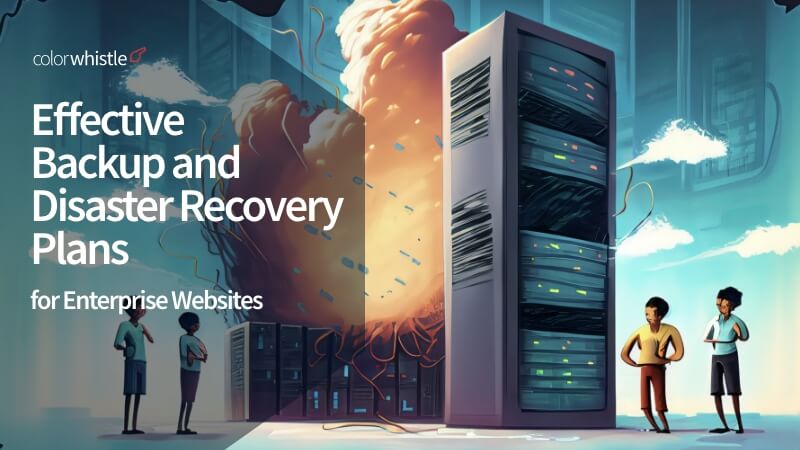Enterprise websites serve as the lifeline of businesses, facilitating communication, transactions, and overall operations. However, the increasing reliance on these web platforms also exposes companies to potential risks such as cyber-attacks, hardware failures, natural disasters, or human errors. To safeguard against such disruptions and ensure business continuity, an effective backup and disaster recovery plan is paramount.
A real-time incident would help you to understand the importance of a disaster recovery plan in a better way,
The fire at the OVH data center in France caused a major problem for data center owners. This also worried millions of business owners worldwide about how to keep their data safe and have a backup plan in case something goes wrong. The fire showed that unexpected things can happen, and having a disaster recovery plan in place is important.
A big cloud provider in Europe lost a huge amount of its customers’ data on March 10, 2021, because of the fire. Along with the building, owned by OVH cloud, was destroyed in the fire it has also damaged a data center that was nearby, as the building suffered to an extreme extent it could hardly restart as planned. The fire accident created a lot of issues for OVH, like many websites and apps around the world stopped working. Some businesses prepared themselves with a disaster recovery plan and for them this was a temporary difficulty. However, for many businesses it was an irreversible loss which led them to experience data and financial loss because of the fire accident at OHV. This incident made millions of business owners to seriously consider creating a proper disaster backup and recovery plan for their businesses.
With the above incident as a lesson in this blog, we will delve into the comprehensive backup and disaster recovery strategy for enterprise websites, helping enterprises build resilience, protect valuable data, and minimize downtime. At ColorWhistle, we provide comprehensive WordPress development services.
Did You Know?
A survey found that more than half of businesses have experienced a downtime incident in the past 5 years that lasted at least one full workday (8+ hours)
What is a Disaster Recovery Plan, and Why is it Important?
A disaster recovery plan (DR) is all about setting processes and strategies to restore critical business systems, operations, and data to normal functioning after a disruptive event, such as a natural disaster, cyber-attack, hardware failure, or human error.
The goal of a disaster recovery plan is minimizing downtime, and data loss, and ensuring business continuity, preserving the organization’s ability to serve customers, partners, and stakeholders.
Importance of Disaster Recovery Plan
- Business continuity
- Minimizing downtime
- Data protection
- Mitigating financial loss
- Regulatory compliance
- Preparedness for unforeseen events
- Risk management
- Maintaining customers’ trust
- Quick recovery from cybersecurity incidents
- Preserving brand reputation and image
- Competitive advantage
Effective Backup and Disaster Recovery Plans for Enterprise Websites

Assessment and Risk Analysis
The first step in creating a robust backup and disaster recovery plan is conducting a thorough assessment and risk analysis. This involves identifying critical systems, applications, and data vital for the website’s seamless functioning. Simultaneously, enterprises must evaluate potential threats and vulnerabilities to understand the likelihood of different disaster scenarios. The information gathered during this phase forms the foundation for subsequent decisions regarding resource allocation and the level of protection required for different aspects of the website.
Defining RPO and RTO
Two key metrics govern the effectiveness of a disaster recovery plan: Recovery Point Objective (RPO) and Recovery Time Objective (RTO). RPO establishes the maximum acceptable data loss during a disaster. It is crucial to determine this parameter based on the impact data loss would have on business operations and compliance requirements. On the other hand, RTO denotes the desired time frame for recovery after a disaster. This metric sets the target duration for the website to be fully operational again. Striking the right balance between RPO and RTO is essential to avoid data loss while minimizing downtime.
Developing a Comprehensive Backup Strategy
A robust backup strategy establishes the backbone of a disaster recovery plan. Regularly backing up all critical data and website files is fundamental to ensure minimal data loss during a disaster. Depending on the RPO and RTO requirements, enterprises can employ different backup methods, such as full backups or incremental backups. Full backups capture the entire website and data, while incremental backups record changes made since the last backup, reducing the backup duration. To bolster redundancy, organizations should store backups in multiple locations, such as on-premises servers and secure offsite facilities.
Testing and Verifying Backups
Regular testing and verification of backups are paramount to ensuring their integrity and effectiveness during a disaster. Automated backup testing and verification tools streamline this process, validating backups automatically and generating reports. Testing backups in controlled environments allows businesses to identify and address potential issues proactively, bolstering confidence in the recovery process. Regularly updating and testing the disaster recovery plan through simulated scenarios also helps personnel understand their roles and enhances the plan’s overall effectiveness.
Formulating a Disaster Recovery Plan
A well-crafted disaster recovery plan details the step-by-step procedures for recovering the website and data during various disaster scenarios. It should encompass actions for hardware failures, cyber-attacks, natural disasters, and human errors. Assigning specific roles and responsibilities to staff members is crucial to execute the plan efficiently. Conducting drills and simulations regularly helps organizations evaluate the effectiveness of the plan and ensures employees are well-prepared to handle emergencies.
Ensuring Redundancy and High Availability
To enhance website availability, consider hosting the website on redundant servers or utilizing a content delivery network (CDN) with multiple points of presence. Load balancing effectively distributes traffic across these servers, minimizing the risk of overloading and ensuring continuous access to the website in case of a server failure.
Utilizing Offsite Backups
Storing backups in secure, offsite locations safeguards against physical disasters that may affect the primary data center. Offsite backups offer a safe copy of the data, enabling recovery even if the main facility becomes damaged or inaccessible. Using encrypted connections when transferring data to offsite locations maintains data privacy and mitigates the risk of unauthorized access.
Implementing Data Encryption
Implementing data encryption for sensitive information at rest and during transit strengthens data security. Encryption protects data from unauthorized access, even if physical media is stolen or intercepted during transmission. Employing robust encryption algorithms and adhering to secure key management practices ensures the confidentiality and integrity of the data.
Monitoring and Alerting
Implementing a comprehensive monitoring system is crucial for tracking the health and performance of the website and its infrastructure. Configuring the system to send alerts when predefined thresholds are exceeded or when potential security issues are detected allows for early detection and quicker response times, reducing the impact of potential incidents.
Regular Updates and Security Patches
Regularly updating all software, including the operating system, web server, and applications, is essential to ensure the latest security patches are applied. Keeping the system up-to-date helps address known vulnerabilities and minimizes the risk of security breaches.
Employee Training
Providing proper training to employees ensures they understand the disaster recovery plan and their specific roles during a crisis. Raising awareness about potential security risks and best practices empowers employees to identify and respond appropriately to potential threats.
Considering Third-Party Providers
When relying on third-party services, ensuring they have robust backup and disaster recovery plans in place is crucial. Reviewing Service Level Agreements (SLAs) ensures they align with the enterprise’s recovery objectives.
Documentation
Maintaining detailed documentation of all backup and disaster recovery procedures ensures the recovery process can be executed effectively, even during stressful situations. Keeping this documentation up-to-date and accessible to relevant personnel is essential for seamless recovery.
Regular Review and Improvement
Periodically reviewing and updating the backup and disaster recovery plan is essential to accommodate changes in technology, business requirements, and potential threats. Continuous improvement based on lessons learned from testing, real incidents, and industry best practices enhances the plan’s effectiveness and adaptability.
Did You Know?
Only 54% of organizations have a company-wide disaster recovery plan in place.
The Importance of Disaster Recovery Plans for Various Niches
Explore a few examples of disaster recovery plans in various niches which also depict the importance of having one.
Financial Institutions
Banks and financial institutions are required to have robust disaster recovery plans due to the criticality of their services. For example, after Hurricane Katrina in 2005, a major bank in the affected region activated its disaster recovery plan, ensuring the continuity of critical banking operations. They quickly established backup data centers in secure locations, allowing customers to access their accounts and conduct transactions seamlessly.
E-commerce Companies
These heavily rely on their websites for revenue generation. In the event of a website outage or cyber-attack, a well-designed disaster recovery plan is essential. For example, a large e-commerce retailer faced a distributed denial-of-service (DDoS) attack that temporarily rendered their website inaccessible. Through their disaster recovery plan, they promptly redirected traffic to a secondary server, enabling customers to continue shopping without significant disruption.
Healthcare Organizations
Hospitals and healthcare facilities must maintain their operations, especially during emergencies. A hospital with a comprehensive disaster recovery plan experienced a power outage due to severe weather. Thanks to their plan, they had backup generators in place, ensuring uninterrupted power supply for critical medical equipment and services.
Cloud Service Providers
Cloud service providers themselves have disaster recovery plans to safeguard their clients’ data and services. In 2017, a major cloud provider experienced a significant outage affecting some of its services. The provider quickly executed its disaster recovery plan, restoring service functionality within a few hours and ensuring minimal data loss for its customers.
Manufacturing Industry
Manufacturing companies often face the risk of production disruptions due to unforeseen events. For example, a manufacturing plant experienced a fire that damaged its production facility. Thanks to its disaster recovery plan, the company had alternative production sites identified and ready to take over operations, minimizing downtime and fulfilling customer orders.
Educational Institutions
Educational institutions rely on their IT infrastructure for administrative tasks and online learning. When a university’s data center experienced a hardware failure, its disaster recovery plan automatically redirected traffic to an offsite data center, ensuring continuous access to online services for students and staff.
Government Agencies
Government agencies need to maintain critical services during emergencies. For instance, a city’s emergency response system faced a technical failure during a natural disaster. The city’s disaster recovery plan facilitated the quick restoration of the system, allowing timely responses to emergencies and citizen safety.
Business Continuity vs Disaster Recovery Plan
Factors
Business Continuity Plan
Disaster Recovery Plan
Focus
Focuses on the organization’s ability to continue essential operations and services during and after a disaster or disruptive event.
Focuses on restoring critical IT systems and data after a disaster or disruptive event to resume normal operations.
Scope
Encompasses all aspects of the organization, including people, processes, technology, facilities, and external stakeholders.
Primarily focuses on IT infrastructure, data, and related processes.
Objective
The primary objective is to maintain business operations with minimal disruption and ensure continuity of critical services.
The primary objective is to recover IT systems and data to bring them back to operational status.
Time Frame
Business Continuity Plans are long-term strategies, that address both short-term and long-term disruptions.
Disaster Recovery Plans are more short-term and immediate, aimed at restoring IT systems as quickly as possible.
Proactive vs Reactive
Business Continuity Plans are proactive and involve preventive measures, risk assessments, and contingency planning.
Disaster Recovery Plans are more reactive, focusing on recovery actions after a disruptive event has occurred.
Involvement of Stakeholders
Involves all levels of the organization, including top management, business units, employees, suppliers, and customers.
Involves IT staff, system administrators, and technology vendors primarily responsible for IT recovery efforts.
Recovery Time Objectives (RTO)
Business Continuity Plans may have varying RTOs depending on the criticality of services, ranging from hours to days.
Disaster Recovery Plans usually have shorter RTOs, aiming for a quicker recovery.
Recovery Point Objectives (RPO)
Business Continuity Plans may have varying RPOs, depending on the nature of data and processes, ranging from hours to days.
Disaster Recovery Plans also have varying RPOs, aiming to minimize data loss, often measured in minutes or hours.
Testing and Validation
Business Continuity Plans require regular testing, simulations, and updates to ensure their effectiveness.
Disaster Recovery Plans also require regular testing to verify that recovery procedures work as intended.
Next Step: Plan Your Disaster Recovery Plan Today
A well-crafted backup and disaster recovery plan is a vital investment to safeguard enterprise websites and ensure business continuity in the face of unforeseen challenges.
By conducting a comprehensive risk analysis, defining appropriate RPO and RTO, implementing redundant solutions, and regularly testing backups, organizations can build resilience and protect valuable data. With careful planning and continuous improvement, enterprises can confidently navigate potential disruptions, maintain customer trust, and uphold their position in the competitive digital landscape.
For more professional and efficient disaster recovery tips you can contact ColorWhistle by sending us a message or calling us at +1 (919) 234-5140, we’ll get back to you at the earliest. We provide services tailored to your requirements that suit your business. We are also experts at website development services, web designing, and as well as digital marketing services, we also specialize in social media design services you can approach us for any of these services to make a robust online presence for your business.
What’s Next?
Now that you’ve had the chance to explore our blog, it’s time to take the next step and see what opportunities await!





